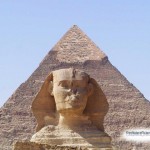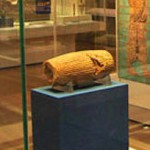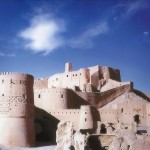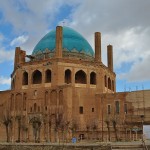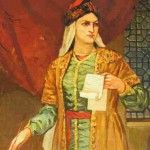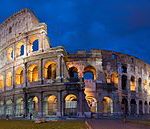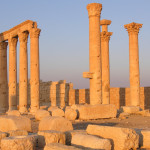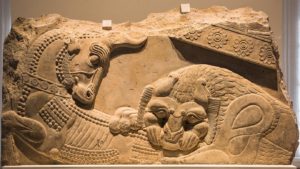 The lion and the bull have been fighting, locked in stone, for nearly 2,500 years—ever since an ancient sculptor carved them into a slab of black limestone and set them into a
The lion and the bull have been fighting, locked in stone, for nearly 2,500 years—ever since an ancient sculptor carved them into a slab of black limestone and set them into a
monumental staircase at Persepolis, the royal center of the great Achaemenid Empire. The two animals were meant to reflect the prestige of this vast Persian empire, which fell in 330 B.C. when Alexander the Great sacked and burned Persepolis and its opulent palaces. The giant stone relief remained there among the ruins until 1931, when the University of Chicago’s Oriental Institute began a landmark excavation of the site—and gave the lion and bull a second life.
For the past 80 years, the 4,000-pound stone relief was on loan to the Boston Museum of
Fine Arts. But it has returned to the University of Chicago in honor of the OI’s 100th anniversary as one of the world’s foremost research centers on the civilizations of the
ancient Middle East. The rare artifact is available for public viewing at the Oriental
Institute Museum starting on September 28th, when the OI will host a public celebration—the first in a yearlong series of centennial events open to the University community and the general public.
Prof. Christopher Woods, director of the OI, discusses excavation work done in
Persepolis and the significance of the ancient relief.
Video by UChicago Creative
“We are thrilled to have this magnificent relief back in Chicago to help celebrate the OI’s
century of transformative research on the ancient Middle East,” said Christopher Woods,
director of the OI and the John A. Wilson Professor of Sumerology. “The beauty and
majesty of the relief just leaps out at you.”
The relief dates to about the fourth century B.C., when Persepolis stood as the ceremonial
center of the Achaemenid Empire, which spanned much of the ancient Middle East.
“Looking at this monumental imagery gives you insights into the imperial ideology—how the Achaemenid kings conceived of themselves and the identity they wanted to project,” said Woods, a leading scholar of Sumerian language and writing.
“The image of a lion and bull in combat has a long tradition in the ancient Middle East,
stretching back thousands of years,” said Jean M. Evans, chief curator and deputy
director of the OI Museum. “In the relief, these noble and powerful animals are
marshalled to reflect the power and prestige of the empire.” The 4,000-pound stone relief was recently returned to the OI for public viewing.
Photo by Jean Lachat
Rising to power in approximately 550 B.C., the Achaemenid Empire was the largest
empire the world had known; its extensive central administration set the model for later
empires and is an essential piece of understanding the journey of human civilization. But
after just two centuries, Persepolis—and the empire—fell when Alexander the Great’s
armies sacked the city in 330 B.C.
According to Roman historian Plutarch, it took 20,000 mules and 5,000 camels to carry
away the treasure Alexander’s army looted from Persepolis. Left behind, however, were
columns and halls, staircases and gates—all finely carved by the craftsmen of the
Achaemenid royal court.
Many of these were still standing two millennia later, when the OI began a pioneering
excavation that spanned eight years and required hundreds of workmen. Over the multi-
acre site, the excavation uncovered everything from the kings’ cups and bowls to the
treasures looted during the Achaemenid conquests of other kingdoms.
“The beauty and majesty of the relief just leaps out at you.”
—Prof. Christopher Woods, director of the OI
Hundreds of cuneiform tablets, preserved by their baking in the fires that consumed the
rest of the city, filled out the details of life in ancient Persepolis. From them, scholars
learned everything from land deals and taxes to how much haoma, the sacred intoxicating
drink, should be used during religious services.
While much of what was excavated remains on site at Persepolis, several large pieces,
such as the head of a colossal bull that once guarded the Hundred-Columned Hall, in
addition to smaller finds, were given to the OI by Iranian authorities in recognition of the
work that went into uncovering and preserving the ancient site and were shipped to
Chicago, where they have been on display at the OI Museum for nearly a century. The
relief of a lion and bull in combat, however, went on long-term loan to Boston Museum
of Fine Arts. In honor of the OI’s centennial, the Museum made plans to bring the stone relief back to Chicago.



